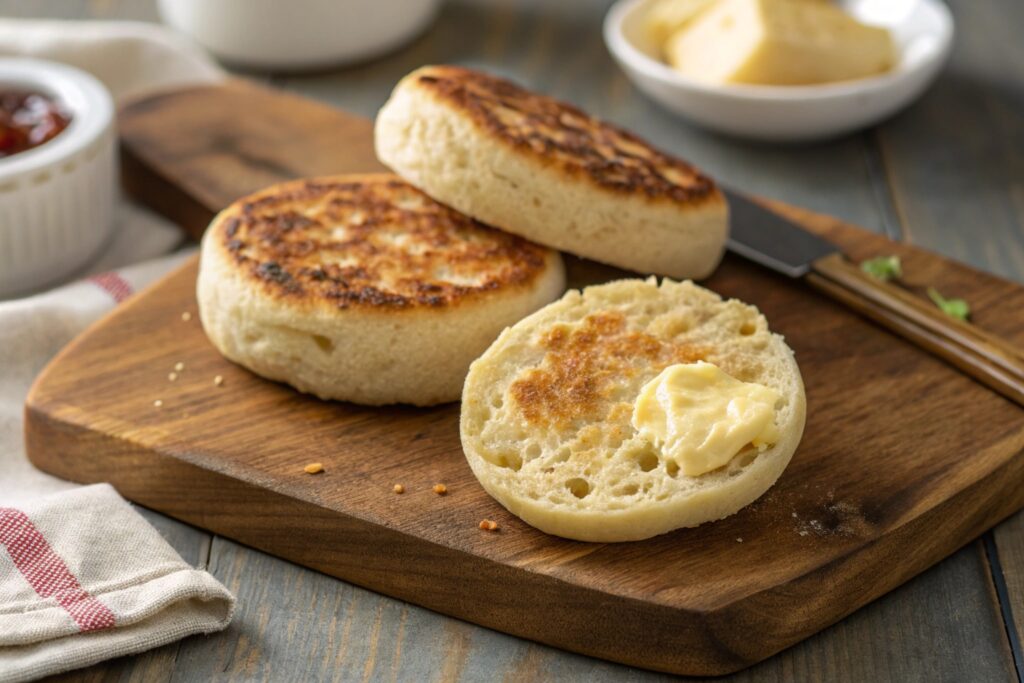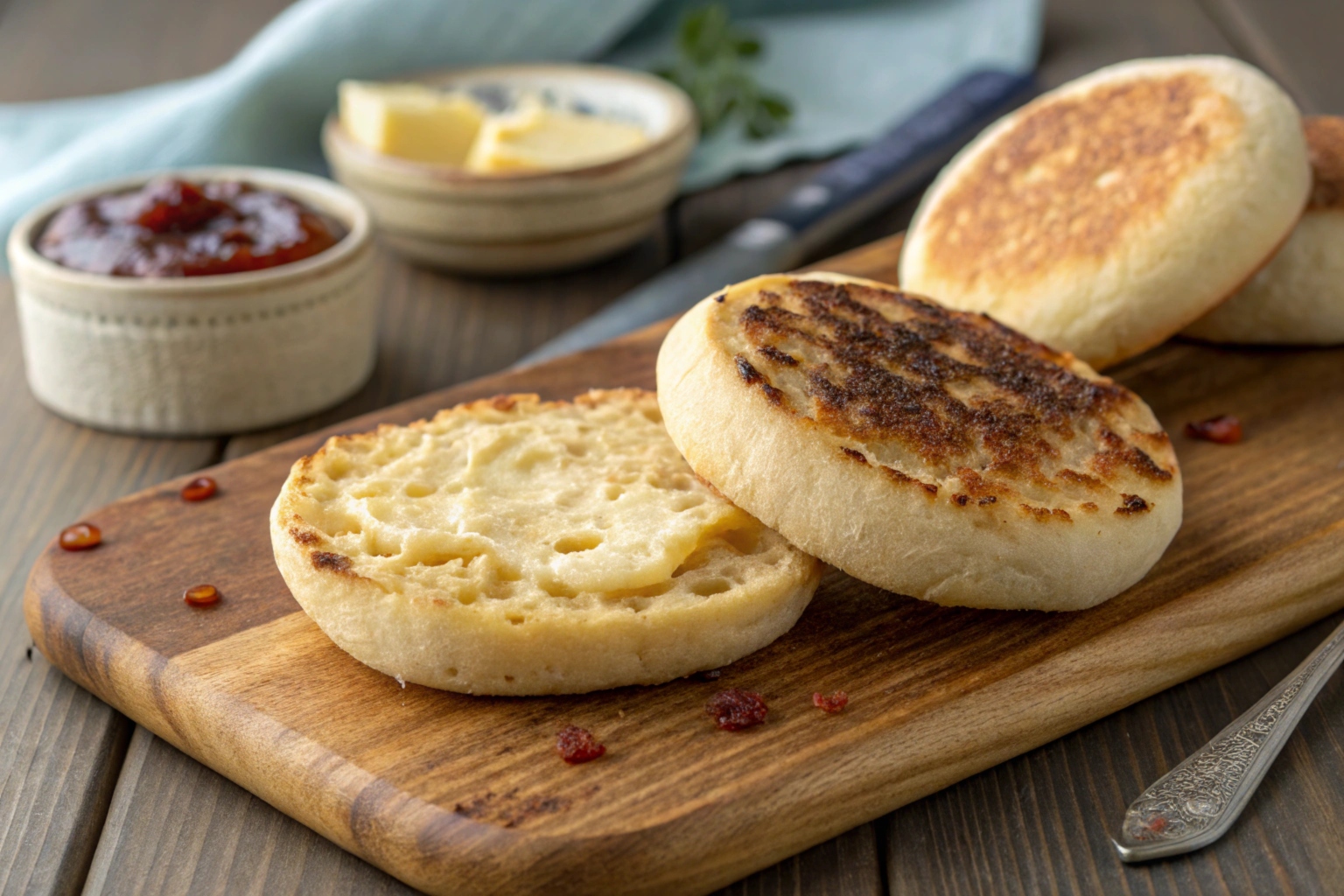English muffins are a beloved breakfast staple, known for their soft texture, golden crust, and signature nooks and crannies. These versatile baked goods are perfect for spreading butter and jam, building hearty breakfast sandwiches, or even serving as a base for creative dishes like English muffin pizzas. While store-bought options are convenient, nothing compares to the flavor and satisfaction of making them at home. Whether you’re a novice baker or a seasoned pro, this guide will walk you through everything you need to know about crafting the perfect English muffins, from traditional recipes to sourdough variations and beyond.
Key Ingredients for English Muffins
English muffins rely on a few simple yet essential ingredients to create their iconic taste and texture. These include:
- All-purpose or bread flour: For the structure and soft crumb.
- Yeast: Typically dry or instant yeast is used to make the dough rise.
- Milk: Warm milk contributes to a tender texture.
- Unsalted butter: Adds a buttery flavor and richness.
- Sugar: A small amount for sweetness and to help activate the yeast.
- Salt: Enhances flavor and balances sweetness.
- Cornmeal: Used for dusting to prevent sticking and add texture.
These pantry staples, combined with a few additional touches like a pinch of sugar or honey, create a dough that’s versatile and delicious.
Essential Supplies for Baking
To ensure success, gather the following supplies:
- Mixing bowls for combining ingredients.
- Stand mixer with a dough hook attachment to simplify kneading.
- Measuring cups and spoons for accuracy.
- Rolling pin and biscuit cutter or cookie cutter for shaping.
- Cast-iron skillet or nonstick skillet for cooking.
- Parchment paper and baking sheets for proofing and transferring dough.
- Plastic wrap or clean kitchen towels for covering the dough during proofing.
Having the right tools on hand ensures a smooth process from start to finish.
Traditional English Muffin Recipe
Making traditional English muffins is straightforward and rewarding. Here is a tried-and-true recipe:
Ingredients:
- 3 1/2 cups all-purpose or bread flour
- 1 packet (2 1/4 tsp) dry yeast
- 1 cup warm milk (around 110°F)
- 2 tbsp granulated sugar
- 1/4 cup unsalted butter, melted
- 1/2 tsp salt
- 1/2 cup lukewarm water
- Cornmeal for dusting
Step-by-Step Instructions for Traditional Muffins
- Activate the Yeast: Combine warm water, a pinch of sugar, and yeast in a bowl. Let it sit until frothy (5-10 minutes).
- Mix the Dough: In a large mixing bowl, combine flour, sugar, and salt. Gradually add the yeast mixture, warm milk, and melted butter. Mix until a shaggy dough forms.
- Knead: Use a stand mixer with a dough hook attachment or knead by hand on a floured surface for 8-12 minutes until the dough is smooth and elastic.
- First Proof: Transfer the dough to a greased bowl, cover with plastic wrap, and let it rise in a warm spot for 1-2 hours or until doubled in size.
- Shape the Muffins: Roll the dough out to about 1/2 inch thick. Use a 3-inch cookie cutter to cut rounds. Dust with cornmeal and place on a parchment-lined baking sheet. Re-roll excess dough as needed.
- Second Proof: Cover the rounds with a clean kitchen towel and let them rise for an additional 30-60 minutes.
- Cook: Preheat a skillet over medium-low heat. Place muffins on the skillet and cook for 4-5 minutes on each side until golden brown. Reduce heat if they brown too quickly.
- Cool: Transfer to a cooling rack. Allow to cool slightly before slicing.
Sourdough English Muffin Recipe
For those who prefer a tangy twist, sourdough English muffins are a delightful alternative.
For a tangy variation, try sourdough English muffins. Discover more about sourdough techniques here.
Ingredients:
- 1 cup active sourdough starter
- 2 1/2 cups bread flour
- 3/4 cup warm milk
- 2 tbsp sugar
- 1/4 cup melted butter
- 1/2 tsp salt
- Cornmeal for dusting
Detailed Process for Sourdough Variations
- Prepare the Starter: Ensure your sourdough starter is active and bubbly.
- Mix Dough: Combine the starter, milk, sugar, and melted butter in a mixing bowl. Gradually add flour and salt. Mix until a soft dough forms.
- Bulk Fermentation: Transfer the dough to a greased bowl. Cover and let ferment at room temperature for 4-8 hours or until doubled in size.
- Shape and Proof: Follow the same shaping and proofing steps as the traditional recipe.
- Cook: Cook on a medium-low heat skillet as described earlier. The result is a tangy, chewy muffin perfect for breakfast sandwiches.
Common Baking Techniques

Master these techniques for perfect English muffins:
- Controlling Dough Hydration: Sticky dough can be tricky to work with, but adding a bit of flour (sparingly) helps maintain balance. Avoid using too much flour, which can result in dense muffins.
- Maintaining Consistent Heat: Skillets should be preheated and kept at medium-low heat. Uneven heat can lead to burnt exteriors and undercooked centers.
- Using Cornmeal: Dusting with cornmeal prevents sticking and creates a lightly textured crust.
- Proper Proofing: The dough needs adequate time to double in size, which develops the flavor and ensures the characteristic airy interior.
- Gentle Handling: Handle the dough lightly when shaping and transferring to preserve air pockets essential for the nooks and crannies.
Tips for Achieving Nooks and Crannies
The hallmark of a great English muffin is its airy, craggy interior. To achieve this:
- Proper Hydration: Use slightly higher hydration doughs to allow for steam formation during cooking.
- Minimal Shaping: Avoid deflating the dough when cutting and shaping. Handle it gently to preserve air bubbles.
- Slow Cooking: Use a skillet over low heat to allow the interior to steam and create pockets while the exterior browns.
- Don’t Over-Knead: Over-kneading creates a uniform texture rather than the uneven structure ideal for trapping butter and spreads.
Baking Schedule for Optimal Results
A well-organized schedule helps simplify the process and ensures the best flavor:
- Day 1 Evening: Mix and proof the dough overnight in the refrigerator. This slow fermentation enhances flavor and allows flexibility in your baking schedule.
- Day 2 Morning: Remove dough from the fridge, shape into rounds, and let them proof for an additional 30-60 minutes.
- Cooking Time: Plan for about 10-15 minutes of cooking per batch on the skillet.
Total time can range from 12 to 18 hours, depending on proofing times and your schedule, with most of it being hands-off.
Storage Tips for Freshness
Proper storage keeps your muffins fresh and delicious:
- Room Temperature: Store in an airtight container or wrapped in foil for up to 3 days.
- Refrigeration: Not recommended as it can dry out the muffins.
- Freezing: Wrap each muffin individually in plastic wrap, then place in a freezer-safe bag. Freeze for up to 3 months.
- Reheating: Toast frozen muffins directly without thawing for the best texture.
Serving Suggestions for English Muffins
Enjoy English muffins in a variety of ways:
- Breakfast: Top with butter, jam, or honey for a simple start to your day.
- Savory Sandwiches: Use as a base for breakfast sandwiches with eggs, sausage, or bacon.
- Creative Ideas: Make mini pizzas with marinara, cheese, and toppings.
- Dessert: Spread with Nutella or sweetened cream cheese and top with fresh fruit.
Their versatility makes them a favorite for any meal or snack.
FAQs
Can English muffins be frozen?
Yes, English muffins freeze exceptionally well. Wrap them individually and store in a freezer-safe bag for up to 3 months. Toast directly from frozen for convenience.
What is the difference between English muffins and bagels?
English muffins are cooked on a skillet and have a soft, airy texture with nooks and crannies. Bagels are boiled before baking, resulting in a dense, chewy texture.
How do you toast English muffins for best results?
Slice them in half with a serrated knife, then toast until golden brown. For an extra crisp texture, use a toaster oven or broil briefly.
Troubleshooting Common Issues
Dense Muffins: Causes and Solutions
- Causes: Insufficient proofing, over-kneading, or using too much flour.
- Solutions: Allow enough time for the dough to rise and use a kitchen scale for accurate measurements.
Overly Thick Muffins: Adjustments to Make
- Causes: Rolling the dough too thick or not pressing the cutter firmly.
- Solutions: Roll dough to a uniform 1/2 inch thickness and use a sharp biscuit cutter.
Variations and Flavor Additions
- Adding Herbs and Seasonings: Incorporate rosemary, thyme, or garlic powder for savory muffins. Experiment with combinations for unique flavors.
- Sweet Variations with Fruits and Spices: Add cinnamon, nutmeg, or dried fruits like raisins and cranberries for a sweet twist. Top with a dusting of powdered sugar for a bakery-style touch.
Conclusion and Final Tips
English muffins are a versatile and rewarding baking project that can elevate any meal. With attention to detail and the tips outlined here, you can achieve bakery-quality results. Whether you enjoy them plain, toasted, or topped with your favorite spreads, they’re sure to become a staple in your kitchen. Happy baking!
For more breakfast ideas and inspiration, explore egg recipes or discover a world of culinary possibilities with other versatile baked goods.


4 thoughts on “Best English Muffin Recipe for Breakfast Lovers”